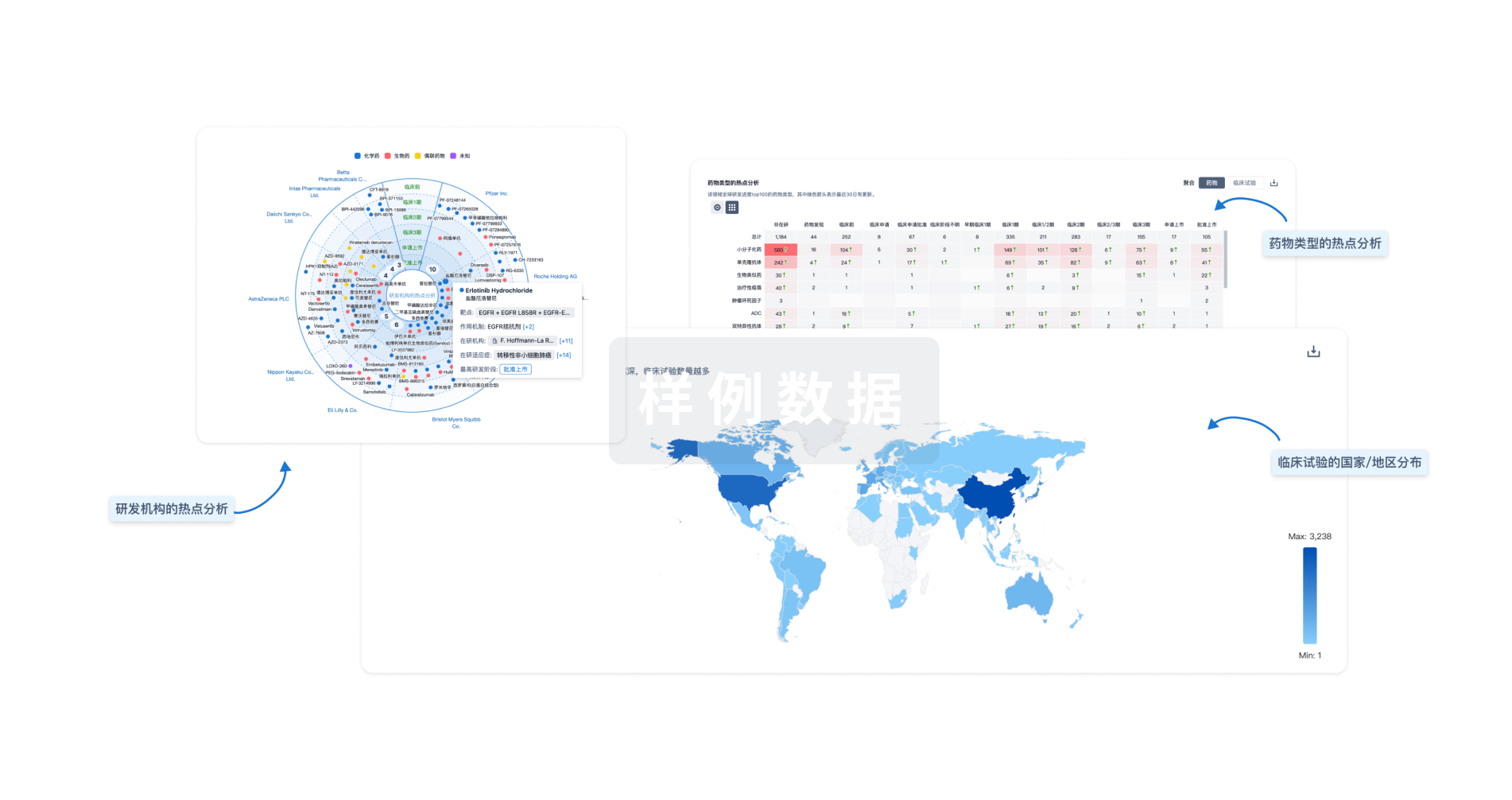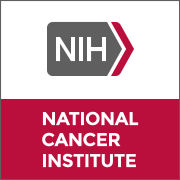预约演示
更新于:2025-05-07
Choriocarcinoma
绒毛膜癌
更新于:2025-05-07
基本信息
别名 CHORIOCARCINOMA、Choriocarcinoma、Choriocarcinoma (disorder) + [25] |
简介 A malignant metastatic form of trophoblastic tumors. Unlike the HYDATIDIFORM MOLE, choriocarcinoma contains no CHORIONIC VILLI but rather sheets of undifferentiated cytotrophoblasts and syncytiotrophoblasts (TROPHOBLASTS). It is characterized by the large amounts of CHORIONIC GONADOTROPIN produced. Tissue origins can be determined by DNA analyses: placental (fetal) origin or non-placental origin (CHORIOCARCINOMA, NON-GESTATIONAL). |
关联
14
项与 绒毛膜癌 相关的药物靶点 |
作用机制 PD-1抑制剂 |
在研适应症 |
最高研发阶段批准上市 |
首次获批国家/地区 日本 |
首次获批日期2014-07-04 |
靶点 |
作用机制 CTLA4抑制剂 |
非在研适应症 |
最高研发阶段批准上市 |
首次获批国家/地区 美国 |
首次获批日期2011-03-25 |
作用机制 DHFR抑制剂 [+2] |
原研机构 |
在研适应症 |
最高研发阶段批准上市 |
首次获批国家/地区 美国 |
首次获批日期2004-02-04 |
39
项与 绒毛膜癌 相关的临床试验NCT06941766
Efficacy and Safety of Iparomlimab and Tuvonralimab (QL1706) in the Treatment of Intermediate Trophoblastic Tumors: A Prospective, Multicenter, Single-arm Trial
This clinical trial aims to evaluate the efficacy and safety of Iparomlimab and Tuvonralimab (QL1706), a dual-targeting immunotherapy (anti-PD-1/CTLA-4), in patients with intermediate trophoblastic tumors (ITT).
The main questions it aims to answer are:
Does QL1706 improve complete response (CR) rates (primary endpoint) and survival outcomes? What are the safety profiles of QL1706 in ITT, including immune-related adverse events? Participants will receive QL1706 (5 mg/kg IV, Q3W) ± chemotherapy (FAEV/EMA/EP/EMA/CO/TP-TE). They will also receive Maintenance therapy post-hCG normalization. Efficacy is assessed via serial β-hCG tests, imaging (every 9-12 weeks), and biomarker analysis.
The main questions it aims to answer are:
Does QL1706 improve complete response (CR) rates (primary endpoint) and survival outcomes? What are the safety profiles of QL1706 in ITT, including immune-related adverse events? Participants will receive QL1706 (5 mg/kg IV, Q3W) ± chemotherapy (FAEV/EMA/EP/EMA/CO/TP-TE). They will also receive Maintenance therapy post-hCG normalization. Efficacy is assessed via serial β-hCG tests, imaging (every 9-12 weeks), and biomarker analysis.
开始日期2025-04-15 |
申办/合作机构 北京协和医院 [+5] |
ChiCTR2500099044
A single arm, single-center study of the efficacy and safety in uterine sparing surgery for stage I placental site trophoblastic tumor (PinkRing study)
开始日期2025-04-01 |
申办/合作机构 |
CTR20243494
甲氨蝶呤片在空腹及餐后条件下的人体生物等效性试验
主要研究目的
研究健康受试者在空腹及餐后条件下,单次口服由海南卓科制药有限公司提供的甲氨蝶呤片(受试制剂,规格:2.5mg)与相同条件下单次口服由Pfizer Japan Inc.持证的甲氨蝶呤片(参比制剂,商品名:METHOTREXATE®,规格:2.5mg)的药动学特征,评价两制剂间的生物等效性,为该受试制剂注册申请提供依据。
次要研究目的
观察健康受试者在空腹及餐后条件下单次分别口服1片受试制剂或1片参比制剂的安全性。
开始日期2024-10-10 |
申办/合作机构 |
100 项与 绒毛膜癌 相关的临床结果
登录后查看更多信息
100 项与 绒毛膜癌 相关的转化医学
登录后查看更多信息
0 项与 绒毛膜癌 相关的专利(医药)
登录后查看更多信息
6,794
项与 绒毛膜癌 相关的文献(医药)2025-06-01·Pediatric Blood & Cancer
Primary Ovarian Non‐Gestational Placental Site Trophoblastic Tumor in a Pediatric Patient: A Case Report and Review of the Literature
Letter
作者: Hull, Nathan C. ; McChesney, Marissa K. ; Ishitani, Michael B. ; Bendel, Emily C. ; Allen‐Rhoades, Wendy A. ; Demirel, Nadir ; Shahi, Maryam
2025-05-01·American Journal of Surgical Pathology
SALL4 as a Useful Marker for the Distinction of Various Gestational Trophoblastic Disease Subtypes
Article
作者: Golfier, François ; Devouassoux-Shisheboran, Mojgan ; Descargues, Pierre ; Bolze, Pierre A. ; Mauduit, Claire ; Donzel, Marie ; Trecourt, Alexis ; Allias, Fabienne ; Hajri, Touria ; Gaillot-Durand, Lucie
2025-05-01·International Journal of Gynecological Pathology
Bilateral Somatically Derived Germ Cell Tumors With 12p Gains Arising in High-grade Serous Carcinomas of the Ovary: A Case Report and Review of the Literature
Review
作者: Samuelson, Megan I. ; Masaadeh, Amr H. ; Dundar, Bilge ; Bashir, Amani ; Kadera, Evangeline
14
项与 绒毛膜癌 相关的新闻(医药)2025-03-05
·药事纵横
在新药研发的漫漫征途中,药物首次进入临床试验,无疑是一个极具意义的重大里程碑。这背后意味着相关靶点已完成了基因表达、蛋白质结构和功能等多方面的生物学功能验证,极有可能在对应疾病的发病机制里扮演着关键角色,为攻克疾病带来新的希望。今天,就让我们一同深入了解几个在2月崭露头角、首次进入临床的重要靶点。
OMA1:线粒体健康的“守护者”与疾病治疗新靶点
OMA1是位于线粒体内膜的锌金属蛋白酶,由OMA1基因编码。它在维持线粒体动态平衡和应激响应方面发挥着核心作用。当细胞遭遇应激,如膜电位丧失或线粒体损伤时,OMA1就会被激活,它会切割线粒体融合蛋白OPA1的长亚型,抑制线粒体融合并促进裂变。不仅如此,OMA1还能降解DELE1和PINK1等蛋白,通过调控线粒体自噬和细胞凋亡,影响细胞的最终命运。比如在细胞凋亡过程中,Bax/Bak蛋白聚集激活OMA1,引发一系列反应,最终触发凋亡。
OMA1的表达与多种疾病紧密相关。在骨肉瘤中,OMA1高表达与肿瘤发生和肺转移有关,敲除它能抑制肿瘤生长;但在肺腺癌里,OMA1低表达却通过抑制PI3K/AKT通路,减少癌细胞增殖。此外,OMA1缺失的小鼠会出现肥胖、代谢异常和线粒体功能障碍,这表明它在代谢疾病方面也有着潜在的影响。目前,抗真菌药物环吡罗可诱导OMA1自裂解,抑制肿瘤发展;而某些激酶抑制剂却可能因激活OMA1引发心脏毒性。由此可见,OMA1不仅是线粒体质量控制的关键调节因子,更是多种疾病治疗的潜在重要靶点。
BTM-3566:基于OMA1靶点的抗癌新星
BTM-3566是Bantampharma开发的OMA1小分子激动剂,它的出现为癌症治疗带来了新的曙光。BTM-3566能够诱导OMA1激活,进而使线粒体蛋白OPA1和DELE1裂解,激活HRI激酶,磷酸化eIF2a。eIF2a则调节综合应激反应(ISR),根据细胞环境触发稳态适应或细胞凋亡,以此来对抗癌细胞。
BTM-3566的研究进展备受关注。它在2021年ASH会议上初次亮相,目前正在开展1期临床试验(NCT06792734),用于治疗复发/难治性成熟B细胞淋巴瘤,预计2026年初公布临床试验结果。
在抗癌效果上,BTM-3566表现十分亮眼。对具有高风险基因组改变(如Myd88突变和MYC、BCL2重排)的人类DLBCL PDX模型研究发现,100%的细胞系都有反应,8个PDX模型中有6个肿瘤完全消退。
在套细胞淋巴瘤方面,BTM-3566能抑制细胞增殖并诱导凋亡,且不受伊布替尼和维奈克拉耐药状态的影响。在不同的动物模型中,BTM-3566也展现出强大的实力,在CDX和多种耐药的PDX小鼠模型中,几乎能完全抑制肿瘤生长。
而且,BTM-3566不局限于血液瘤,在实体瘤如绒毛膜癌和食管癌中也有一定的肿瘤抑制效果,尽管效果不如血液瘤,但已经为实体瘤治疗提供了新的思路。
从商业化角度来看,弥漫性大B细胞淋巴瘤市场前景广阔。2023年,该市场规模达到39亿美元,预计到2034年将增长至52亿美元,2024 - 2034年期间的增长率 (CAGR) 为2.7%。套细胞淋巴瘤作为非霍奇金淋巴瘤的亚类,占比6% - 8%。全球套细胞淋巴瘤治疗市场预计2024年达到25.3亿美元,并在2024 - 2034年以8.6%的复合年增长率扩大。
目前,在OMA1靶点的药物研发领域,Bantampharma处于领先地位,其研发的BTM-3566和BTM-3528为众多患者带来了新的希望。
CAPN2:隐藏在细胞深处的“多面手”靶点
CAPN2属于钙蛋白酶家族,是一种钙依赖性、非溶酶体半胱氨酸蛋白酶。它在细胞中身兼数职,是细胞骨架重塑与信号转导的“调节者”,通过有限蛋白水解作用,分解关键底物,调节细胞的结构和功能。在神经元领域,CAPN2参与神经元刺激诱导的CPEB3蛋白水解裂解,影响CPEB3靶标mRNA的翻译,与轴突退化密切相关。此外,它在肿瘤发生与转移过程中也扮演着重要角色,比如在胰腺癌中,CAPN2上调可通过Wnt/β-Catenin信号通路调节上皮间质转化,促进肿瘤细胞的增殖、迁移和侵袭。
AMX-0114:靶向CAPN2,为神经疾病带来希望
AMX0114是Amylyx开发的靶向CAPN2的反义寡核苷酸。它能靶向CAPN2蛋白酶活性位点中的一个外显子,通过RNase H介导的降解降低CAPN2 mRNA转录本的水平,从而减少细胞中功能性钙蛋白酶2蛋白的含量。
目前,AMX0114正在加拿大进行ALS(肌萎缩侧索硬化症)的1期临床试验(NCT06665165)。在多项研究中,AMX0114展现出了良好的治疗潜力。在诱导多能干细胞衍生的运动神经元模型中,预处理AMX0114后,再暴露于神经毒性化合物,结果显示它能显著降低细胞外神经丝轻链(NfL)水平,而NfL是中枢神经系统疾病中轴突损伤的生物标志物,这意味着AMX0114在减轻神经损伤方面效果显著。
在携带ALS相关TDP-43(M337V)突变的诱导多能干细胞衍生神经元模型中,AMX0114不仅改善了神经元的生存率,还降低了细胞外NfL水平。
在氧化应激诱导的神经细胞死亡模型中,AMX0114预处理的神经元在过氧化氢暴露下,细胞体面积保留率远高于对照组,显著抑制了CAPN2的活性,实现了有效的神经保护。
在商业价值方面,目前获批的ALS新药托夫生(Tofersen,QALSODY)已取得一定的销售成绩,2024年全球销售额达3200万美元。专业人士预计AMX0114峰值年销售额可达1.5亿美元。2023年,全球ALS治疗市场规模为6.673亿美元,预计2024 - 2030年将以5.8%的复合年增长率增长,其中药物治疗占比63.1%,干细胞治疗也在快速发展。
目前针对CAPN2靶点的在研药物仅6款,竞争相对不激烈,这也为AMX0114的发展提供了广阔空间。
结语
这些首次进入临床的靶点,无论是OMA1、CAPN2,还是基于它们开发的BTM-3566、AMX0114,都在各自的领域展现出了巨大的潜力。它们不仅为相关疾病的治疗带来了新的方向,也为医药市场注入了新的活力。让我们共同期待这些靶点和药物在未来能取得更多的突破,为患者带来更多的希望!
参考资料
1.Shammas MK, Huang X, Wu BP, et
al. OMA1 mediates local and global stress responses against protein misfolding
in CHCHD10 mitochondrial myopathy. J Clin Invest. 2022;132(14):e157504.
doi:10.1172/JCI157504
2.Bantampharma website
3.Coherent Market Insight
4.Grand View Research
5.Amylyx Website
药事纵横投稿须知:稿费已上调,欢迎投稿
临床1期临床结果临床终止
2025-02-19
·药咖荟
肿瘤标志物(tumor marker,TM)很多,但每个指标什么意义,适用于什么肿瘤?笔者对其进行了总结,希望对大家有所帮助。
一、常见、通用的肿瘤血清 TM
1、癌胚抗原(CEA)
CEA升高常见于大肠癌、胰腺癌、胃癌、乳腺癌、甲状腺髓样癌、肝癌、肺癌、卵巢癌、泌尿系肿瘤等。但吸烟、妊娠期和心血管疾病、糖尿病、肠道憩室炎、直肠息肉、结肠炎、胰腺炎、肝硬化、肝炎、肺部疾病等,15%~53%的患者血清CEA也会升高,所以CEA不是恶性肿瘤的特异性标志,在诊断上只有辅助价值。
大量临床实践证实,术前或治疗前CEA浓度能明确预示肿瘤的状态、存活期及有无手术指征等。术前CEA浓度越低,说明病期越早,肿瘤转移、复发的可能越小,其生存时间越长;反之,术前CEA浓度越高说明病期较晚,难于切除,预后差。
CEA检测还可对经手术或其他方法治疗使CEA恢复正常的病人,进行长期随访,监测其复发和转移。通常采用以下方案:术后第六周一次;术后三年内,每月一次;3~5年每三月一次;5~7年每半年一次;7年后一年一次。若发现升高,两周后再测一次,两次都升高则提示复发和转移。
正常参考值≤5ng/mL
2、癌抗原125(CA125)
CA125最常见于上皮性卵巢肿瘤(浆液性肿瘤)患者的血清中,其诊断的敏感性较高,但特异性较差。黏液性卵巢肿瘤中不存在。80%的卵巢上皮性肿瘤患者血清CA125升高,但近半数的早期病例并不升高,故不单独用于卵巢上皮性癌的早期诊断。90%患者血清CA125与病程进展有关,故多用于病情检测和疗效评估。95%的健康成年妇女CA125的水平≤40U/ml,若升高至正常值的2倍以上应引起重视。
各种恶性肿瘤引起的腹水中也可见CA125升高。CA125升高也可见于多种妇科良性疾病,如卵巢囊肿、子宫内膜病、宫颈炎及子宫肌瘤、胃肠道癌、肝硬化、肝炎等。
正常参考值<35u/mL。
3、癌抗原15-3(CA15-3)
癌抗原15-3是乳腺癌的辅助诊断指标,但在乳腺癌早期敏感性不高。早期阳性率为60%,转移性乳腺癌阳性率为80%。癌抗原15-3也是术后随访,监测肿瘤复发、转移的指标。
增高:见于乳腺癌、肺癌、结肠癌、宫颈癌等。乳腺、卵巢等非恶性肿瘤阳性率一般低于10%。
正常参考值:≤25 U/ml
4、癌抗原19-9(CA19-9)
血清癌抗原19-9可作为胰腺癌。胆囊癌等恶性肿瘤的辅助诊断指标。胚胎期胎儿的胰腺、胆囊、肝、肠等组织存在这种抗原,正常人体组织中含量很低;在消化道恶性肿瘤,尤其是胰腺癌、胆囊癌病人血清中,癌抗原19-9含量明显增高,但早期诊断价值不大,主要作为病情监测和预示复发的指标。此外,对消化道疾病鉴别诊断(如胰腺癌与胰腺炎。胃癌与胃溃疡)亦有一定价值。
增高:见于胰腺癌、胆囊癌、胃癌、结肠癌、肝癌等;急性胰腺炎、胆囊炎、肝炎等也有不同程度的升高。
正常参考值:≤27 U/ml
5、癌抗原50(CA50)
癌抗原50是一种非特异性的广谱肿瘤标志物,与癌抗原19-9有一定的交叉抗原性,主要用于胰腺癌、结肠/直肠癌、胃癌的辅助诊断,其中胰腺癌病人增高最明显。
增高:见于胰腺癌(阳性率可达87%)、结肠/直肠癌、胃癌、肺癌。肝癌。卵巢癌、乳腺癌等恶性肿瘤;溃疡性结肠炎、肝硬化、黑色素瘤、淋巴瘤、自身免疫性疾病等也增高。
另有报导萎缩性胃炎患者胃液CA50的浓度与正常人比较有显著改变。通常认为萎缩性胃炎是癌前高危期,因此CA50可作为癌前诊断指标之一。在胰腺炎、结肠炎和肺炎发病时,CA50也会升高,但随炎症消除而下降。
正常参考值:0~20 U/ml
6、癌抗原242(CA242)
CA242是一种新的肿瘤相关抗原,当消化道发生肿瘤时,其含量升高。对胰腺癌、结直肠癌有较高的敏感性与特异性,分别有86 %和62 %的阳性检出率,对肺癌、乳腺癌也有一定的阳性检出率。用于胰腺癌和良性肝胆疾病的鉴别诊断及预后,也用于结直肠癌病人术前预后及复发鉴别。
CEA与CA242联合检测可提高敏感性,与单独采用CEA检测相比,对结肠癌可提高40~70%,对直肠癌提高达到47~62%。CEA与CA242无相关性,具有独立的诊断价值,且二者之间具有互补性。
正常参考值:0~20 U/ml
7、小细胞肺癌相关抗原(神经元特异性烯醇化酶,NSE)
NSE被认为是监测小细胞肺癌的首选标志物,60~80%的小细胞肺癌患者NSE升高。在缓解期,80~96%的患者NSE含量正常,如NSE升高,提示复发。小细胞肺癌患者首轮化疗后24~72小时内,由于肿瘤细胞的分解,NSE呈一过性升高。因此,NSE是监测小细胞肺癌疗效与病程的有效标志物,并能提供有价值的预后信息。
NSE也可作为神经母细胞瘤的标志物,对该病的早期诊断具有较高的临床应用价值。神经母细胞瘤患者的尿中NSE水平也有一定升高,治疗后血清NSE水平降至正常。血清NSE水平的测定对于神经母细胞瘤的监测疗效和预报复发均具有重要参考价值,比测定尿液中儿茶酚胺的代谢物更有意义。
另外对胺前体摄取脱羧细胞瘤、精原细胞瘤及其它脑肿瘤的诊断也有重要意义。
正常参考值:0~16.3 ng/ml
8、鳞状细胞癌抗原(SCC)
鳞状细胞癌抗原(SCC)是一种特异性很好而且是最早用于诊断鳞癌的肿瘤标志物。SCC在正常的鳞状上皮细胞中抑制细胞凋亡和参与鳞状上皮层的分化,在肿瘤细胞中参与肿瘤的生长,它有助于所有鳞状上皮细胞起源癌的诊断和监测,例如:子宫颈癌、肺癌(非小细胞肺癌)、头颈部癌、食管癌、鼻咽癌以及外阴部鳞状细胞癌等。这些肿瘤患者血清中SCC升高,其浓度随病期的加重而增加。临床上用于监测这些肿瘤的疗效、复发、和转移以及评价预后。
对子宫颈癌有较高的诊断价值:对原发性宫颈鳞癌敏感性为44%~69%;复发癌敏感性为67%~100%,特异性90%~96%;其血清学水平与肿瘤发展、侵犯程度及有否转移相关。在宫颈癌根治术后SCC浓度显著下降;可及早提示复发,50%患者的SCC浓度升高先于临床诊断复发2~5个月,它可以作为独立风险因子加以应用。
辅助诊断肺鳞癌:肺鳞癌阳性率为46.5%,其水平与肿瘤的进展程度相关,它配合CA125、CYFRA21-1和CEA联合检测可提高肺癌患者诊断的灵敏性。
食管鳞癌、鼻咽癌的预测:阳性率随病情发展而上升,对于晚期患者,其灵敏性可达73%,联合检测CYFRA21-1和SCC可以提高检测的灵敏性。III期头颈部癌阳性率为40%,IV期时阳性率增至60%。
其它鳞癌的诊断和监测:头颈癌、外阴癌、膀胱癌、肛管癌、皮肤癌等。
正常参考值:< 1.5μg/L
二、肺癌血清 TM
9、非小细胞肺癌相关抗原(CYFRA 21-1)
CYFRA 21-1是非小细胞肺癌最有价值的血清肿瘤标志物,尤其对鳞状细胞癌患者的早期诊断、疗效观察、预后监测有重要意义。CYFRA 21-1也可用于监测横纹肌浸润性膀胱癌的病程,特别是对预计膀胱癌的复发具有较大价值。如果肿瘤治疗效果好,CYFRA 21-1的水平会很快下降或恢复到正常水平,在疾病的发展过程中,CYFRA 21-1值的变化常常早于临床症状和影像检查。
CYFRA 21-1与良性肺部疾病(肺炎、结核、慢性支气管炎、支气管哮喘、肺气肿)的鉴别特异性比较好。
正常参考值:0~3.3 ng/ml
10、胃泌素释放肽前体(ProGRP)
胃泌素前体释放肽是一种新的小细胞肺癌标志物。PROGRP是脑肠激素的一种,是小细胞肺癌增殖因子胃泌素释放肽的前体。
PROGRP作为小细胞肺癌标志物有以下特点:
针对小细胞肺癌的特异性非常高;
较早期的病例有较高的阳性率;
健康者与患者血中浓度差异很大,因而检测的可靠性很高。
具体应用:
肺腺癌:CEA(87%)、CA153
肺鳞癌:SCC、CYFRA21-1
小细胞肺癌:pro-GRP、NSE
非小细胞肺癌三联:CYFRA21-1 + CEA + p53
肺转移:CA199、CA153
复发:CEA
三、胃癌血清 TM
11、癌抗原72-4(CA72-4)
CA72-4是目前诊断胃癌的最佳肿瘤标志物之一,对胃癌具有较高的特异性,其敏感性可达28-80%,若与CA19-9及CEA联合检测可以监测70 %以上的胃癌。CA72-4水平与胃癌的分期有明显的相关性,一般在胃癌的Ⅲ-Ⅳ期增高,对伴有转移的胃癌病人,CA72-4的阳性率更远远高于非转移者。CA72-4水平在术后可迅速下降至正常。在70%的复发病例中,CA72-4浓度首先升高。与其它标志物相比,CA72-4最主要的优势是其对良性病变的鉴别诊断有极高的特异性,在众多的良性胃病患者中,其检出率仅0.7 %。
CA72-4对其他胃肠道癌、乳腺癌、肺癌、卵巢癌也有不同程度的检出率。CA72-4与CA125联合检测,作为诊断原发性及复发性卵巢肿瘤的标志,特异性可达100 %。
正常参考值:≤6.9 U/ml
没有一种能满足早期诊断的敏感度和特异性,通常联合诊断。癌前病变和初期:CA199、CA242、CA724、CEA 升高。
四、结直肠癌血清 TM
12、内皮细胞特异分子-1(ESM-1)
ESM-1(内皮细胞特异分子-1)正常<37.0 ng/mL,结直肠癌敏感度 90.91%、特异度 95%,随TNM分期升高而上升。
CEA、CA242、CA199 三者较敏感,然而联合检测不优于单一 CEA。
五、肝癌血清 TM
13、甲胎蛋白(AFP)
AFP(甲胎蛋白) 正常≤20ng/mL,无肝病活动、排除妊娠和生殖腺胚胎癌,≥400ng/mL 持续 1 月或≥200ng/mL 持续 2 月者,结合影像检查可诊断肝癌。肝硬化、肝炎患者中 AFP 也会升高,但一般不超过 300 ng/ml。
甲胎蛋白主要由胎儿肝细胞及卵黄囊合成。甲胎蛋白在胎儿血液循环中具有较高的浓度,出生后则下降,至生后2~3月甲胎蛋白基本被白蛋白替代,血液中较难检出,故在成人血清中含量极低。甲胎蛋白具有很多重要的生理功能,包括运输功能、作为生长调节因子的双向调节功能、免疫抑制、T淋巴细胞诱导凋亡等。
甲胎蛋白与肝癌及多种肿瘤的发生发展密切相关,在多种肿瘤中均可表现出较高浓度,可作为多种肿瘤的阳性检测指标。目前临床上主要作为原发性肝癌的血清标志物,用于原发性肝癌的诊断及疗效监测。在转移性肝癌中,AFP值一般低于350~400 ng/ml。
14、α-L-岩藻糖苷酶(AFU)
AFU是对原发性肝细胞性肝癌检测的又一敏感、特异的新标志物。原发性肝癌患者血清AFU活力显著高于其它各类疾患(包括良、恶性肿瘤)。血清AFU活性动态曲线对判断肝癌治疗效果、估计预后和预报复发有着极其重要的意义,甚至优于AFP。但是,值得提出的是,血清AFU活力测定在某些转移性肝癌、肺癌、乳腺癌、卵巢或子宫癌之间有一些重叠,甚至在某些非肿瘤性疾患如肝硬化、慢性肝炎和消化道出血等也有轻度升高,在使用AFU时应与AFP同时测定,可提高原发性肝癌的诊断率,有较好的互补作用。
正常参考值:0~40 IU/L
六、前列腺癌血清 TM
15、总前列腺特异性抗原(TPSA)
PSA是前列腺癌的特异性标志物,也是目前公认的唯一具有器官特异性肿瘤标志物。血清TPSA升高一般提示前列腺存在病变(前列腺炎、良性增生或癌症)。血清PSA是检测和早期发现前列腺癌最重要的指标之一,血清TPSA定量的阳性临界值为大于10 μg/L,前列腺癌的诊断特异性达90%~97%。TPSA也可用于高危人群前列腺癌的筛选与早期诊断,是第一个由美国癌症协会推荐用于筛查50岁以上男性前列腺癌的肿瘤标志物。
TPSA测定还可用于监测前列腺癌患者或接受激素治疗患者的病情及疗效,90%前列腺癌术后患者的血清TPSA值可降至不能检出的痕量水平,若术后血清TPSA值升高,提示有残存肿瘤。放疗后疗效显著者,50%以上患者在2个月内血清TPSA降至正常。
正常参考值:≤4.400 ng/ml
16、游离前列腺特异性抗原(FPSA)
单项的血清总PSA(TPSA)测定不能明确鉴别前列腺癌和良性的前列腺增生,主要是因为在浓度2~20 ng/ml范围内,二组病人有交叉。而FPSA/TPSA不受此因素及年龄的影响,通过FPSA/TPSA比值达到鉴别前列腺癌或良性的前列腺增生的目的。前列腺癌患者的FPSA/TPSA比值明显偏低,良性的前列腺增生患者的FPSA/TPSA比值显著增高。FPSA/TPSA界限指定为0.15,低于该值高度怀疑前列腺癌,其诊断敏感性为90.9%,特异性为87.5%,准确性为88.6%,明显优于TPSA单独测定。
FPSA检测主要适用于未经治疗、TPSA值为2~20 ng/ml病人,当TPSA值低于2 ng/ml或高于20 ng/ml时,FPSA/TPSA比值并不能用于鉴别前列腺癌和良性的前列腺增生。
正常参考值:≤1.000ng/ml
FPSA/TPSA:> 0.15
17、前列腺酸性磷酸酶(PAP)
前列腺癌血清PAP升高,是前列腺癌诊断、分期、疗效观察及预后的重要指标。前列腺炎和前列腺增生PAP也有一定程度的增高。
七、卵巢癌血清 TM
18、人附睾蛋白4(HE4)
HE4对于卵巢癌单项特异性、敏感性、准确度较高,CA125 对浆液性卵巢癌的敏感度高于粘液性。
卵巢癌CA125、CA153、AFP、HE4(人附睾蛋白4)较敏感。
八、膀胱癌尿液 TM
19、核基质蛋白-22(NMP-22)
NMP-22(NuclearMatrixProtein-22)是细胞核骨架的组成成分,与细胞的DNA复制、RNA合成、基因表达调控、激素结合等密切相关。膀胱癌中大量肿瘤细胞凋亡将NMP22释放入尿,尿中NMP22可增高达25倍。以10kU/mL为临界值,对膀胱癌诊断的敏感度为70%,特异度78.5%。用于浸润性膀胱癌诊断的敏感度为100%。
九、生殖肿瘤血清 TM
20、人绒毛促性腺激素(HCG)
非妊娠情况下正常<8U/L,肿瘤患者,一般检测β亚单位——β-HCG。HCG是男性睾丸肿瘤和女性恶性滋养细胞肿瘤(葡萄胎、侵袭性葡萄胎、绒毛膜癌)最基本的标记物。
十、其他TM
21、EB病毒抗体(EBV-VCA)
EB病毒阳性、鼻咽癌家族史、鼻咽癌的高发区、身体免疫力低下,都可能是患鼻咽癌的高危因素。从理论上讲,如EB病毒检查阳性者,仅是代表患者以前曾经受过EB病毒感染,但它是否是鼻咽癌发病的直接原因,目前尚无定论。但临床实践,科学研究表明,阳性者患鼻咽癌的机会比阴性者大得多。
EBV-VCA抗体临床意义:VCA-IgA≥1:10为阳性,说明感染过EB病毒(多在半年前或很久很久前),临床上与鼻咽癌、胸腺淋巴上皮癌、胃癌、直肠癌、类风湿性关节炎、非甲非乙型肝炎、红斑狼疮、干燥综合症、Burkitt氏淋巴瘤、免疫缺陷宿主的淋巴瘤等疾病有关。VCA-IgM≥1:5为阳性,说明有近期感染,(感染后多在2~3周该抗体升高,在体内持续时间不等)临床上与不明原因的发烧、乏力、传染性单核细胞增多症、紫癜、抽风、川畸病、口腔脱皮等自身免疫病有关;VCA-IgG≥1:80以上者,说明EBV被激活或激活了其它病毒基因及某些细胞基因,可作为EBV或其它病毒感染的参考招标。
正常参考值:EBV-VCA抗体阴性
22、肿瘤相关物质(TSGF)
TSGF肿瘤相关物质联合检测(原名恶性肿瘤特异性生长因子)是一种可以简便快速地用于恶性肿瘤早期辅助诊断的新型的肿瘤标志物,对疗效观察、人群查体亦有很高的应用价值。由糖类物质构成的糖脂、糖蛋白、寡聚糖等广泛分布于细胞内外和各种体液中,在细胞发生癌变时其代谢紊乱可引起体液中的含量升高,是国际公认的肿瘤标志物;氨基酸及其代谢产物也由于其瘤种特异性小而适用于普查筛选。几种小分子的肿瘤标志物组合在一起合称为TSGF,由于TSGF含量在肿瘤早期血清中即会明显升高,这一特性使其成为广谱恶性肿瘤早期辅助诊断的理想指标。
TSGF也是癌症病人治疗效果及动态随访指标,临床应用资料表明癌症病人治疗前TSGF检测值显著升高,经有效治疗后,患者血清中TSGF值明显下降,甚至降至正常水平;治疗无效或病情恶化、复发或转移的患者,TSGF值反而上升。因此TSGF在疗效观察方面有重要价值,治疗过程中可根据TSGF的检测结果及时调整治疗方案,以期达到最佳治疗效果。
部分急性炎症(肝炎、肺炎等)、自身免疫性疾病如系统性红斑狼疮、类风湿等病症可产生交叉反应,引起假阳性。晚期癌症患者TSGF含量可能低于临界值。
正常参考值:<64U/ml为阴性
23、铁蛋白(SF)
铁蛋白升高可见于下列肿瘤:急性白血病、何杰金氏病、肺癌、结肠癌、肝癌和前列腺癌。检测铁蛋白对肝脏转移性肿瘤有诊断价值,76%的肝转移病人铁蛋白含量高于400μg/L,当肝癌时,AFP测定值较低的情况下,可用铁蛋白测定值补充,以提高诊断率。在色素沉着、炎症、肝炎时铁蛋白也会升高。升高的原因可能是由于细胞坏死,红细胞生成被阻断或肿瘤组织中合成增多。
正常参考值:男性:22~322 μg/L 女性:13~150 μg/L
24、β2-微球蛋(β2-MG)
β2-MG是恶性肿瘤的辅助标志物,也是一些肿瘤细胞上的肿瘤相关抗原。在恶性血液病或其它实质性癌瘤中,突变细胞合成和分泌β2-MG,可使病人血清中浓度显著上升,在淋巴系统肿瘤如慢性淋巴细胞白血病、淋巴细胞肉瘤、多发性骨髓瘤等中尤为明显,在肺癌、乳腺癌、胃肠道癌及子宫颈癌等中也可见增高。由于在肿瘤早期,血清β2-MG可明显高于正常值,故有助于鉴别良、恶性肿瘤。有报道发现恶性疾病时β2-MG在腹水中与血清中的比例明显相关,若两者比值大于1.3时,即考虑为癌肿的表现。
血清β2-MG不但可以在肾功能衰竭、多种血液系统疾病及炎症时升高,而且在多种疾病中均可增高,故应排除由于某些炎症性疾病或肾小球滤过功能减低所致的血清β2-MG增高。脑脊液中β2-MG的检测对脑膜白血病的诊断有特别的意义。
正常参考值:1.58~3.55 μg/ml
25、胰胚胎抗原(POA)
胰胚胎抗原是胰腺癌的又一新型、敏感、特异的新标志物,胰腺癌的POA的阳性率为95%,其血清含量大于20U/ml,当肝癌、大肠癌、胃癌等恶性肿瘤时也会使POA升高,但阳性率较低。
正常参考值:0~7 U/ml
声明
本微信公众号对所有原创、转载的内容、陈述、观点判断均保持中立,推送内容仅供公益性分享,部分转载作品、图片如有作者来源标记有误或涉及侵权,请联系小编删除。
更多优质内容,欢迎关注↓
媒体合作
投稿转载/资料领取/加入社群 请添加药小咖
与/智/者/同/行 为/创/新/赋/能
临床研究
2025-02-09
·健识局
2025年春节过后的第一周,中纪委官网发文再次点名医药腐败。在政策层面,广西、河北等省相继发布公告,要求医院和药店展开自查自纠工作,到4月底之前全国范围的大检查即将到来。
本周,上海阳光医药采购网暂停舒美奇成都生物科技有限公司、CHONG KUN DANG PHARMACEUTICAL CORP旗下的三款注射用头孢唑肟钠产品的挂网销售资格,并未对外公开原因。而内蒙古医药采购中心则公布15个药品挂网价格异常偏高,要求企业进行澄清说明。
在产业层面,原国家药审中心首席科学家、主导2015年药审改革的何如意正式从荣昌生物离职,公司回应已采取适当措施,不会对公司经营造成影响。天士力公告本周发布称:华润三九已获得28%股份,成为公司第一大股东。
此外,武田制药、第一三公更换全球CEO,BD医疗、百特医疗计划拆分,14省117个统筹区实现跨省共济,更多热点健识局整理如下:
重磅政策一览
1.中纪委发文!从源头治理医药腐败
2月6日,中纪委官网发布文章《时代专论丨科学把握当前反腐败斗争形势和任务》,其中再次点名医药腐败。文章指出,二十届中央纪委四次全会明确提出,着重抓好金融、国企、能源、消防、烟草、医药、高校、体育、开发区、工程建设和招投标等领域系统整治。以医药领域为例,需要深化推动医药体制改革,重构整体医药管理体系,并且通过改革有效促进医疗、医保、医药协同发展和治理,从根源上消除医药腐败滋生蔓延的土壤。
2.三个品种被暂停采购,原因未知
2月7日,上海阳光医药采购网发出《关于暂停部分药品采购资格的通知》明确,根据国家医疗保障局有关工作要求,舒美奇成都生物科技有限公司、CHONG KUN DANG PHARMACEUTICAL CORP旗下的三款注射用头孢唑肟钠产品被要求自2月7日起暂停采购资格。该《通知》并未说明这三个品种被暂停采购的原因。
3.大批知名药品挂网价格存在问题
2月5日,内蒙古自治区医药采购中心接连发布通知,通知称部分药品价格存在问题,要求药企提供澄清材料。其中短缺药仅涉及一款产品,远大医药(中国)有限公司的多巴酚丁胺。非短缺药品包括奥美拉唑肠溶胶囊、雷贝拉唑钠肠溶胶囊及利伐沙班片等15个药品。
通知表示,经监测分析,这15个药品挂网价格异常偏高,药企需要对挂网价格高于其他省份挂网价情况进行澄清。
同时,内蒙古还公布了第二批药品澄清情况,未在规定时间内澄清价格还包括一些知名企业,如拜耳的阿卡波糖片、上海百特的氯化钠注射液等都因未能在规定时间内澄清价格,被暂停挂网且被纳入信用评级。
4.多省启动飞检自查
2月5日,广西自治区医保局发布公告称,要求全区所有定点医疗机构和定点零售药店开展自查自纠工作,并明确9大重点领域,分类列出217项典型问题清单。此外,河北省医保近期同样发布类似通知,开展2025年定点医药机构违法违规使用医保基金自查自纠行动。
5.14省117个统筹区实现跨省共济
2024年12月2日,国家医疗保障局在江苏苏州正式启动全国医保个人账户跨省共济。职工医保个人账户可以跨省用于本人近亲属缴纳居民医保和支付医疗费用。
根据国家医保局数据显示,截至2025年2月4日已有河北、内蒙古、上海、江苏、安徽、山东、河南、湖北、广东、重庆、四川、贵州、西藏、甘肃14个省(自治区、直辖市)的117个统筹区开通医保钱包,其中河北、河南、安徽、西藏、四川、湖北6个省级医保部门在全省(自治区)域范围内全面开通医保钱包。
医药卫生大事件
1.何如意从荣昌生物离职
2月6日,荣昌生物公告称,公司执行董事、核心技术人员何如意因个人职业发展原因,不再担任公司核心技术人员,离职后将不再担任公司的任何职务。荣昌生物表示,何如意所负责的工作已完成交接,目前公司的生产经营与技术研发工作均正常开展。
何如意曾在美国食药监局药审中心工作了17年,担任医学主管、医疗团队负责人、代理部门副主任等职务。2015年,作为国家药审中心首席科学家主导本轮药审改革,至2018年10月离开。
2.天士力易主
2月6日,天士力公告称,公司收到华润三九医药股份有限公司的通知,华润三九已收到国务院国资委关于其收购公司的批复。根据协议,控股股东天士力集团及其一致行动人将向华润三九转让4.18亿股股份,占公司总股本的28%。
此外,天士力集团承诺在股份登记日后放弃其所持有的5%股份的表决权,确保其控制的表决权比例不超过12.5008%。此次交易完成后,公司的控股股东将由天士力集团变更为华润三九,实际控制人将由闫希军、吴迺峰、闫凯境、李畇慧变更为中国华润。
3.第一三共、武田更换CEO
第一三共近期宣布,任命 62 岁的奥泽宏幸为公司首席执行官,接替现任首席执行官真锅淳,自2025 年 4 月 1 日起生效。武田制药也宣布,全球总裁、首席执行官兼代表董事卫博科将于 2026 年 6 月从公司退休的消息,董事会一致决定任命现任武田制药美国业务部总裁 Julie Kim 为继任者。
4.百特全球CEO退休
2月3日,百特公司宣布其董事长、总裁兼首席执行官José(Joe)E. Almeida退休。同时,百特也宣布了一系列人事变动。原首席独立董事Shafer先生被任命为董事长兼临时首席执行官。Heather Knight女士将担任新任首席运营官。
除此之外,百特的肾脏护理业务也迎来了重大变革。2025年2月3日,万益特中国在其官方微信上宣布,万益特现已正式成为一家全新独立的重要脏器疗法公司。
5.BD医疗计划2026年完成拆分
2月6日,BD医疗官网发布通知称,计划将生物科学和诊断解决方案业务与其他拆分。此外,BD医疗预计将在2025财年末公布有关分离计划的更多细节,并打算在2026财年完成交易。
拆分后,全新的BD医疗将覆盖医疗必需品、互联护理、生物制药系统、介入治疗四大高增长板块,预计2024财年的收入约为178亿美元,目标市场超700亿美元,年增速约5%。而拆分出来的生物科学与诊断在2024财年收入预计为34亿美元,目标市场超220亿美元。
一周药械盘点
1.司普奇拜单抗第三个适应症获批上市
2月7日,国家药审中心官网显示,康诺亚 1 类新药司普奇拜单抗在国内获批新适应症,用于治疗季节性过敏性鼻炎。除了特应性皮炎、慢性鼻窦炎伴鼻息肉和 SAR 以外,司普奇拜单抗还布局了多个适应症,其中结节性痒疹、哮喘、慢性阻塞性肺病已经进入临床 III 期阶段。
司普奇拜单抗是康诺亚自主研发的一种针对白介素 4 受体α亚基的高效、人源化抗体。2024 年 9 月首次被 NMPA 批准用于治疗外用药控制不佳或不适合外用药治疗的成人中重度特应性皮炎。2024 年 12 月又被批准新适应症,用于治疗慢性鼻窦炎伴鼻息肉。
2.西妥昔单抗国产生物类似药获批上市
2月7日,国家药审中心官网显示,科伦博泰开发的西妥昔单抗注射液生物类似药(A140)的上市申请于近日获得批准。
该产品本次获批适应症为:用于治疗RAS基因野生型的转移性结直肠癌,包括与FOLFOX或FOLFIRI化疗方案联合用于一线治疗,以及与伊立替康联合用于经含伊立替康治疗失败后的患者。此外,该产品还用于治疗头颈部鳞状细胞癌,包括与铂类和氟尿嘧啶化疗联合用于一线治疗复发和/或转移性疾病,以及与放疗联合用于治疗局部晚期疾病。
3.华润双鹤改良型新药获批上市
2月7日,国家药审中心官网显示,华润双鹤申报的改良型新药巯嘌呤微片的上市申请已获得批准。这是一款可精准计量的创新剂型巯嘌呤微片(5mg规格),“体型”缩至芝麻大小。本次获批的适应症是:绒毛膜上皮癌,恶性葡萄胎,成人和儿童急性淋巴细胞白血病及急性非淋巴细胞白血病,慢性粒细胞白血病的急变期。
撰稿 | 雷公
编辑 | 江芸 贾亭
运营 | 雾纪
插图 | 视觉中国
声明:健识局原创内容,未经许可请勿转载
特斯拉创始人马斯克调查美国医保局
中成药集采一半品种流标,独家品种大量退出
中国最老牌的创新药,连续遭遇专利狙击
带量采购高管变更
分析
对领域进行一次全面的分析。
登录
或

Eureka LS:
全新生物医药AI Agent 覆盖科研全链路,让突破性发现快人一步
立即开始免费试用!
智慧芽新药情报库是智慧芽专为生命科学人士构建的基于AI的创新药情报平台,助您全方位提升您的研发与决策效率。
立即开始数据试用!
智慧芽新药库数据也通过智慧芽数据服务平台,以API或者数据包形式对外开放,助您更加充分利用智慧芽新药情报信息。
生物序列数据库
生物药研发创新
免费使用
化学结构数据库
小分子化药研发创新
免费使用



